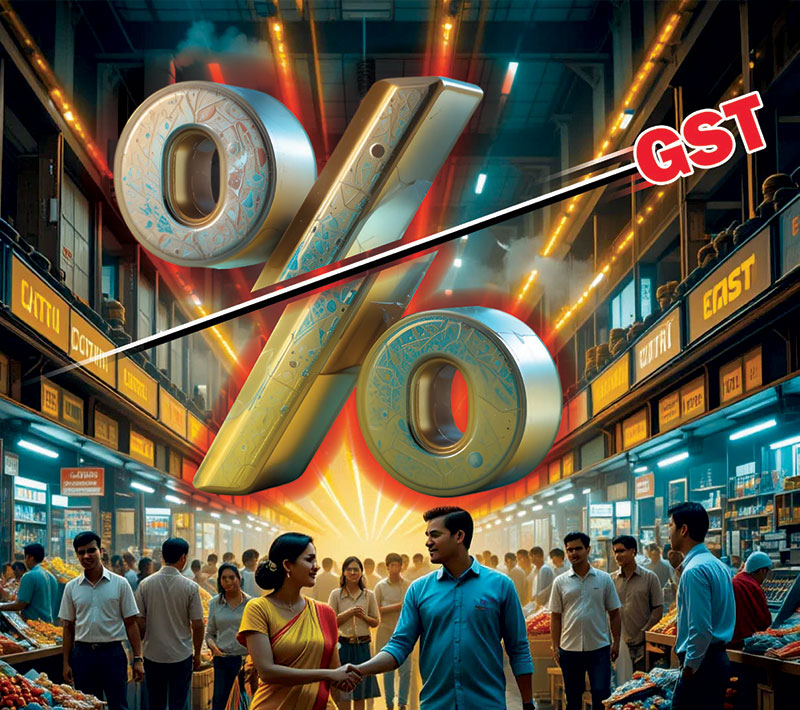The Goods and Services Tax (GST) Council, at its 56th meeting in New Delhi on September 3, approved a major revamp of rates across sectors and verticals. Headed by Finance Minister Nirmala Sitharaman, the Council initiated what the Government has termed as “next-generation GST reforms” which mark a pivotal moment in the evolution of India’s eight-year-old indirect tax regime.
The changes involve restructuring of the existing four rates into two — 5 per cent and 18 per cent — while retaining a steep 40 per cent levy for luxury and so-called “sin goods.”
Cost of most items to come down with rationalisation of GST rates Cuts likely to boost consumption, trigger faster growth
The new regime will take effect from September 22, coinciding with Navratri, with the Government pitching it as a “GST Diwali bonanza” for households, the middle class and farmers.
Prime Minister Narendra Modi hailed the Council’s decision, saying the reforms would benefit every section of society by lowering costs and reducing compliance burdens.
The most immediate relief will be felt by households. Everyday items such as toothpaste, hair oil, soap, shampoo, butter, paneer, packaged drinking water and cereals will now fall in the nil or 5 per cent GST bracket. Kitchen staples like jams, juices and ready-to-eat packaged food have also seen rates cut.
Consumer appliances — televisions, air-conditioners, dishwashers and small cars —have been shifted to the 18 per cent slab from the earlier 28 per cent, sharply reducing costs for middle-income buyers.
Healthcare has received substantial relief. Life and health insurance policies are now GST-free, while life-saving medicines, diagnostic kits, oxygen and spectacles have been exempted or brought under 5 per cent GST. Officials said the move is designed to ease pressure on household budgets and revive consumer confidence at a time when global turbulence is threatening to dent incomes.
For the middle class, squeezed by inflation and uneven job creation, the reforms bring wide-ranging benefits. Hotel rates under Rs 7,500 per room night and economy air tickets will now be cheaper, while rate cuts on textiles, footwear, shampoos and cosmetics are expected to stretch urban family budgets further.
Small cars, hybrid vehicles and motorcycles under 350 cc will also attract just 18 per cent GST, making ownership more affordable. Industry leaders said this could trigger a consumption cycle in autos and consumer goods — sectors that account for large employment.
Farmers and the rural economy are set to gain significantly. Agricultural machinery — from tractors and threshers to irrigation pumps — will now attract only 5 per cent GST. Fertiliser inputs such as sulphuric acid, nitric acid, ammonia, along with biopesticides and micronutrients, have been moved to the same lower bracket.
Officials said the cuts are aimed at easing farm input costs, improving rural purchasing power and reviving demand for FMCG products and two-wheelers. “This is a bottom-up growth stimulus,” a senior finance ministry official said.
Financial markets cheered the announcement. Nifty futures pointed to a strong opening, with consumer goods and auto stocks expected to benefit most. Economists broadly agree that the GST overhaul will boost consumption, though projections differ.
Jefferies estimates the reforms could add 1-1.2 percentage points to GDP growth over the next four to six quarters. IDFC First Bank projects a more modest 0.6 percentage point increase, while SBI Research pegs the boost at Rs.5.3 lakh crore — about 1.6 per cent of GDP. Ambit Capital argues that GST cuts carry a stronger multiplier effect than income-tax reductions, suggesting gains of 0.2-0.5 per cent.
The consensus is that the reform will partially offset the drag from rising US tariffs on Indian exports, helping to stabilise growth above 6 per cent in FY26.
The timing of the move carries political overtones. With several state elections due and the general election cycle not far off, a tax package that makes food, medicines, housing materials, farm inputs and small vehicles cheaper — while retaining punitive levies on luxury cars, aerated drinks and gambling — is likely to resonate widely with voters.



